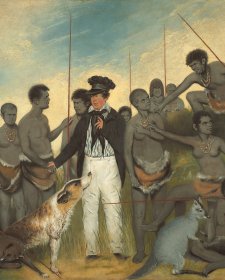Hostilities between colonisers and lutruwita’s (Tasmania’s) First Nations in the late 1820s led to a policy for the removal of Aboriginal people to Wybalenna, a mission station on Flinders Island in Bass Strait. An evangelically-inclined settler named George Augustus Robinson was appointed to bring this policy into effect. Between 1830 and 1835 he conducted a series of expeditions around lutruwita by which Palawa people were persuaded into banishment. The Palawa leaders who acted as Robinson's guides – including Trukanini (c. 1812–1876) and Wurati (d. 1842) – became popular portrait subjects, with artist Benjamin Duterrau making his name with portraits of them and their compatriots. Duterrau's works were valued by colonists as 'correct' records evidencing Robinson's supposed success in 'civilising' Palawa people. Yet what they reveal is that their subjects remained fiercely proud of their traditions and identity, even after removal to Wybalenna. Wurati, for example, refused to adopt European diet or dress and maintained practices such as the use of ochre for his hair and beard; and Trukanini's portrait shows her wearing shell necklaces – the making of which remains a powerful cultural tradition for contemporary Palawa artists.
Purchased with funds provided by The Ian Potter Foundation 2009
The Ian Potter Foundation (13 portraits supported)



On one level The Companion talks about the most famous and frontline Australians, but on another it tells us about ourselves.



Gareth Knapman explores the politics and opportunism behind the portraits of Tasmania’s Black War.



English artist Benjamin Duterrau took up the cause of the Indigenous peoples of Tasmania with his detailed and sympathetic renderings.